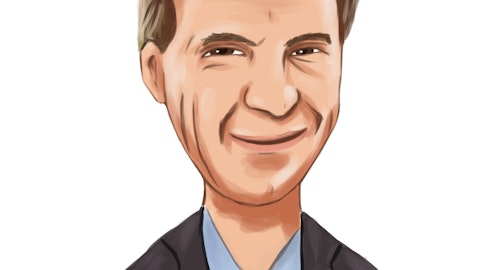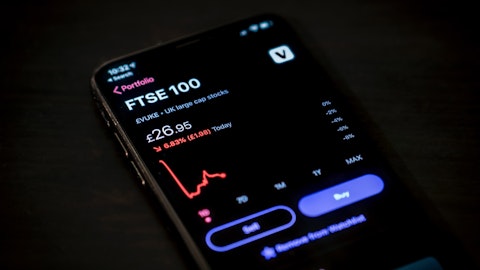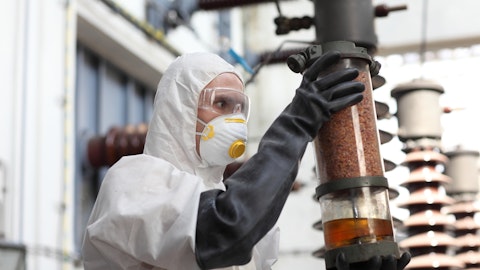Celeste Mastin: Yes. We got $50 million of price in Q4, Mike. And I think as we move forward, I think it’s important for 2023, especially early in the year like this, that we really start talking about price and raw materials as one big bucket, as John described, where we are — we believe there’s $130 million to $160 million of value in that bucket. There’s going to be lots and lots of puts and calls. Our top 25 raw materials make up less than 20% of our raw material cost. And we’ve got pricing actions. We’re still increasing price in some cases where we have raw materials still increasing. We’ve got new product introductions that also kind of makes that a little murky. So collectively, regardless of what happens with raws or price, we think the two of those will generate the incremental EBITDA as we’ve described.
If raws don’t come down, then we’re going to have to continue to raise price. We’re a company that’s demonstrated the ability to do that, and we’ll do that. If raws do come down, it indicates that we’re in a mildly at least recessionary environment, and that’s a great place for this business because that’s where our customers need us more than ever. We really can enable them at times like that to change substrates in their end products, which is going to save them a lot more money than changing their glue. So we feel optimistic about the year ahead, and I just want to like have you start to think about price and raw material in one big category as we move forward.
Mike Harrison: Excellent. Make sense. Thank you very much for answering my questions.
Operator: The next question is from Vincent Anderson with Stifel. Your line is open.
Vincent Anderson: Yes. Thanks and good morning. I wanted to maybe dig in on that last comment that you made, Celeste, because it really feels like you have sort of a dual strategy where ideally, you’re an important technical partner to your customers and trying to increase the value add of your portfolio. But in an environment like this, you’re also trying to maintain a portfolio that offers customers that maybe you’re prioritizing costs an opportunity to trade down. But hopefully, without you suffering a margin hit. So I’m just trying to get a sense for, first, how have conversations with customers drifted between those two types of commercial interactions recently? And do you have a sense for how much of your portfolio you feel like today you could protect with a lower-cost product before suffering either a margin mix hit or just having to decide whether or not to participate at all?
Celeste Mastin: Yes. I think I chose to highlight there kind of our role in enabling customers to be able to reduce the total cost of their product. We enable that through our technical expertise, most certainly. If someone really wants to buy a lower cost adhesive, we have the raw material substitution capabilities and a number of alternative technologies to be able to provide them as well a lower-cost adhesive, something they can save money on and something that’s lower cost to ourselves as well and helps us preserve our margins. So there’s a lot of ways that we interact with the customer to help them achieve their goals. I also don’t want to minimize the fact that most of our conversations with customers revolve around innovation.
We are very focused on bringing new technology, new products to the market. We’ve got 30 different market segments, thousands and thousands of different customers. And so it’s hard for me to generalize directionally if everyone’s going in one matter or another. That’s — it’s really not the case. It’s — every customer we treat very differently. And our ongoing focus is on innovation first.
Vincent Anderson: Okay. Fair enough. That’s helpful. And then if I’m remembering correctly, you’ve had some pretty important wins in HHC, thinking specifically around like consumer beverage and maybe some e-commerce packaging automation technology that you’re participating in. Could you maybe give an update on the cadence of those contributions to HHC growth and maybe just in general terms, assuming those sales take a little longer to ramp up?
Celeste Mastin: Yes. Let me just speak generally about some of those wins because we have — that HHC business has really done an amazing job in that kind of solid, steady CPG space to bring new products to market. We’ve got our sustainable packaging adhesives, which have been really a very big — been a big hit with our packaging customers, something very unique that enables them to be able to make their products more recyclable. We have had a big hit with our new beverage labeling technology to replace casing that enables recyclable bottles to be returned and cleaned more effectively. So we’ve seen a lot of share take in beverage label as a consequence. Those are just two. When you think of others, John
John Corkrean: Hygiene is filling fast.
Celeste Mastin: Yes, we did just win a big application in the hygiene business as well for a fairly unique characteristics that we can bring to an application there. So — yes, that is just a constant ongoing focus for us, Vincent. And we’re seeing those wins really support not just our HHC business, but our other businesses as well.
Vincent Anderson: Got it. Sure. No, that’s helpful. I guess the way I’m trying to frame all of that then is over the next year or two, is HHC still a kind of slow steady business given the number of wins that you piled up there?
Celeste Mastin: Yes. So the objective with that business is get — is to get to mid-teens EBITDA margin. That’s a good level of profitability for that business. And it’s continue to grow kind of mid single-digit, high single-digit over time. So we’re going to continue to take market share in that space and we’re going to continue to grow through innovation. I think if you’re anticipating kind of mid single-digit, high single-digit growth in the HHC business, you’re probably spot on.
Vincent Anderson: Okay. Excellent. And then I just wanted to sneak in a quick one, just checking in on a couple of markets in the EA that we haven’t talked about. It looks like Chinese solar cell numbers have been really strong this year, but you mentioned glass and auto and not solar. So, I just wanted to see how that was going. And then same question, but on electronics.
Celeste Mastin: Yeah. The solar story is really exciting. What we are €“ our solar business is doing well, and that is a business that we’re starting to see migrate around the world. So we are working with big customers to take €“ leverage our expertise that we have in Asia in solar, and bring it to other parts of the world. And I think that’s a great example of a way that we are very strong, being able to take technology and work with big customers, and bring it to new regions successfully, and evolve it for the unique circumstances in those regions is something we’re very good at. Do you want to add something there, John?
John Corkrean: Yeah. I think just to amplify that a little bit, we called out auto and insulated glass. Auto has been a huge growth story for our EA business, particularly electronic vehicles. And we see that, as a continued area that we should be able to drive outsized growth and insulated glass, it’s really an innovation play and even despite some softening in parts of construction, and their products go into construction, they continue to perform very well. Electronics has always been a strong performer. It’s been a little more €“ it’s been a little lower growth still growing, but because of chip shortages and some of the other challenges. And then in the new energy space, that continues to perform well, and we’re seeing the opportunity there from geographic expansion.
It’s historically been a business that’s been sort of China-centric. And we have a strong presence there, but we are really in a competitive advantage as that industry starts to globalize, because we can reach customers more effectively in other geographies than a lot of our competitors. And we have already started to see the benefit of that.




